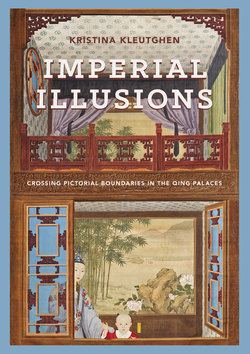Читать книгу Imperial Illusions - Kristina Kleutghen - Страница 24
На сайте Литреса книга снята с продажи.
Оглавлениеlost. As scenic illusions were particular to these artists, Spring’s Peaceful Message would have been immediately identifiable as their work once the illusion had been dispelled.
Despite the important role that European pictorial techniques play in scenic illusions, neither the production of these paintings nor their definition as scenic illusions depended on the presence of European hands: Chinese Wish-Fulfilling Studio painters were producing scenic illusions on their own at least as early as 1738.28 Yet without an artist’s hand immediately visible in the brushwork, there was also no sign of brushes, pigments, or silk. By concealing the process of creation, the agency of the artist, and any material sign that scenic illusions were paintings rather than reality, these erasures initially directed the viewer’s attention to the spaces, objects, and figures depicted instead of to the depiction itself, allowing the paintings to appear to become what they represented.
As Qianlong would have seen it through the doorway in figure I.1, the illusion of Spring’s Peaceful Message is compelling because everything in it appears to be part of the viewer’s world, and therefore creates the desire for touch that generally accompanies illusionistic painting. The complexity of this urge that links sight and touch is increasingly resulting in interdisciplinary studies of vision, cognition, perception, neuroaesthetics, and even neuro–art history, and is essential to fathoming the relationship between psychology and physiology that underpins the perception of illusionistic paintings.29 Perceptually, the formula is simple: if an object seems to project into the viewer’s space, then it must be real, and is therefore touchable. Neuroscience has revealed that visual perception is not defined by a positivist need to either validate or disprove what we see by touching it, but is instead inseparable from the physical preparation for performing an action. It is this interdependence of perception and action that compels a viewer who sees an illusionistic work to touch it.30 The viewer has no expectation of cognitive dissonance or incoherent perception because experience teaches us to trust our senses, particularly the sense of sight. Unlike sight, concentrated in the head, the sense of touch pervades the body through the skin, the largest organ, which in the Chinese tradition was the primary “boundary of affective exchange” between the body and the world.31 As the “sensory faculty that shapes our social connections,” touch connects us physically with others in the myriad contact gestures that define our relationships and their varying levels of intimacy.32 In the case of the hand in particular, touch comprises both agency and receptivity in touching and being touched in return.33
Given the consistent legibility of most European pictorial depth cues in late imperial China, as well as early modern Chinese theories of vision that linked sight and touch with the idea that objects pushed toward the eye,34 perspectival illusionistic paintings in eighteenth-century China resulted in the same “anthropologically constant interaction between sight and touch” as they did in Europe.35 The temptation to touch deeply engages the scenic illusion viewer with the world of the painting, and transmutes the merely visual into the real and tactile. Given the “emotional valence of touch,”36 the most powerful temptations are naturally human: the figures in scenic illusions, which sometimes
